Typical values at TA = +25°C, ADC
Sampling Rate = 2949.12 GHz. Default conditions: output sample rate = 491.52 MSPS
(decimate by 6), PLL clock mode with fREF = 491.52 MHz, AIN =
–3 dBFS, DSA setting = 4 dB.
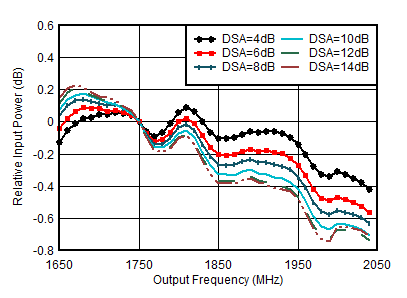
| With
1.8 GHz matching, normalized to 1.75 GHz |
|
Figure 7-309 RX
In-Band Gain Flatness, fIN = 1750 MHz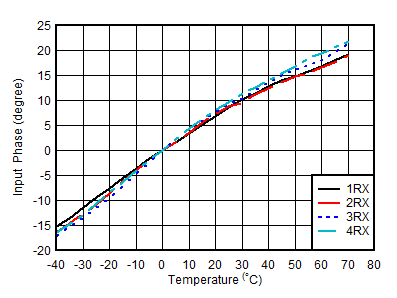
| With
2.6 GHz matching, normalized to phase at 25°C |
|
Figure 7-311 RX
Input Phase vs Temperature and DSA at fIN = 1.75 GHz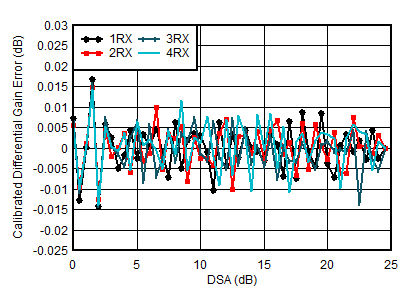
| With
1.8 GHz matching |
| Differential Amplitude Error = PIN(DSA
Setting – 1) – PIN(DSA Setting) + 1 |
Figure 7-313 RX
Calibrated Differential Amplitude Error vs DSA Setting at 1.75 GHz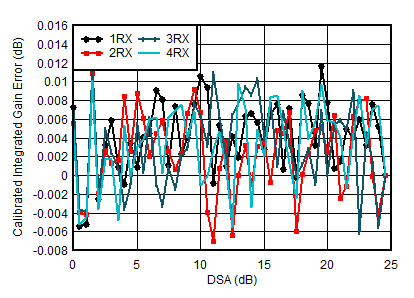
| With
1.8 GHz matching |
| Integrated Amplitude Error = PIN(DSA
Setting) – PIN(DSA Setting = 0) + (DSA
Setting) |
Figure 7-315 RX
Calibrated Integrated Amplitude Error vs DSA Setting at 1.75 GHz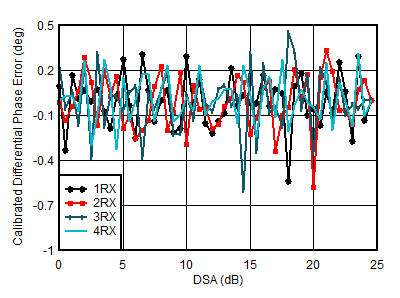
| With
1.8 GHz matching |
| Differential Phase Error = PhaseIN(DSA
Setting – 1) – PhaseIN(DSA Setting) |
Figure 7-317 RX
Calibrated Differential Phase Error vs DSA Setting at 1.75 GHz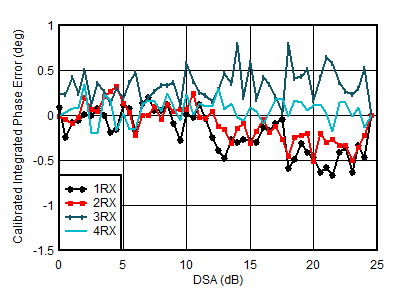
| With
1.8 GHz matching |
| Integrated Phase Error = Phase(DSA Setting) – Phase(DSA
Setting = 0) |
Figure 7-319 RX
Calibrated Integrated Phase Error vs DSA Setting at 1.75 GHz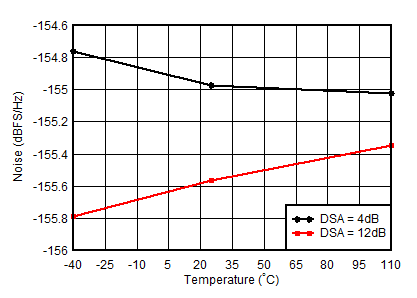
| With
1.8 GHz matching, 12.5-MHz offset from tone |
Figure 7-321 RX
Noise Spectral Density vs Temperature at 1.75 GHz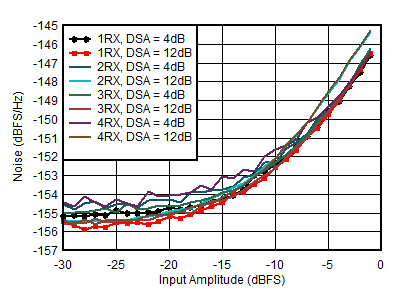
| With
1.8 GHz matching, 12.5-MHz offset from tone |
|
Figure 7-323 RX
Noise Spectral Density vs Input Amplitude and Channel at 1.75 GHz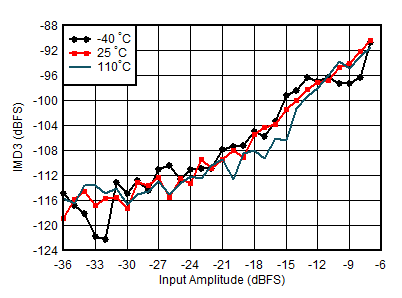
| With
1.8 GHz matching, tone spacing = 20 MHz, DSA = 4
dB |
Figure 7-325 RX
IMD3 vs Input Level and Temperature at 1.75 GHz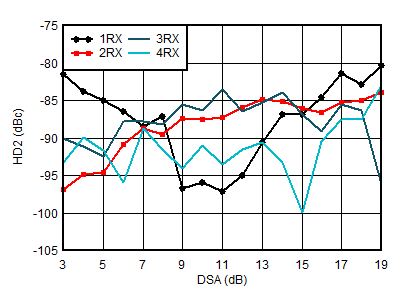
| With
1.8 GHz matching, fin = 1900 MHz, measured
after HD2 trim, DDC bypass mode (TI only mode for
characterization) |
Figure 7-327 RX
HD2 vs DSA Setting and Channel at 1.9 GHz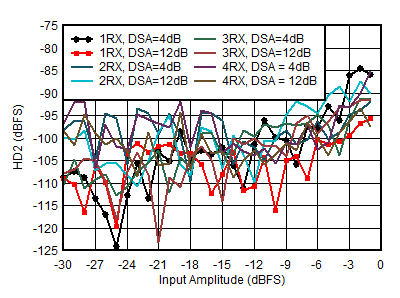
| With
1.8 GHz matching, fin = 1900 MHz, measured
after HD2 trim, DDC bypass mode (TI only mode for
characterization) |
Figure 7-329 RX
HD2 vs Input Amplitude and Channel at 1.9 GHz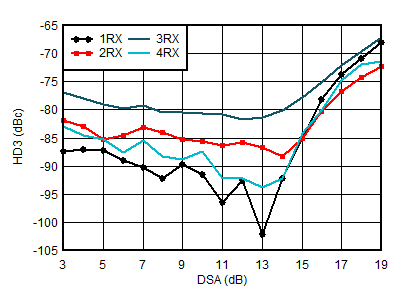
| With
1.8 GHz matching, fin = 1900 MHz, DDC bypass
mode (TI only mode for characterization) |
Figure 7-331 RX
HD3 vs DSA Setting and Channel at 1.9 GHz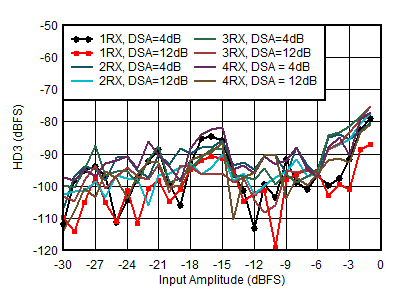
| With
1.8 GHz matching, fin = 1900 MHz, DDC bypass
mode (TI only mode for characterization) |
Figure 7-333 RX
HD3 vs Input Level and Channel at 1.9 GHz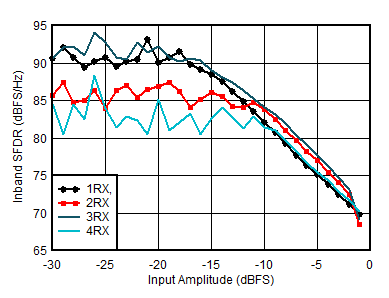
| With
1.8 GHz matching, decimated by 3 |
Figure 7-335 RX
In-Band SFDR (±400 MHz) vs Input Amplitude at 1.75 GHz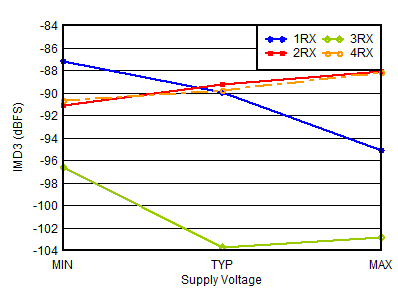
| With
1.8 GHz matching, –7 dBFS each tone, 20-MHz tone
spacing, all supplies at MIN, TYP, or MAX recommended
operating voltages |
Figure 7-337 RX
IMD3 vs Supply and Channel at 1.75 GHz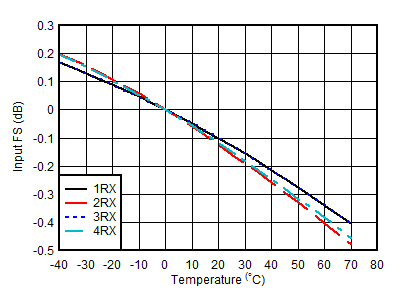
| With
1.8 GHz matching, normalized to fullscale at 25°C for
each channel |
Figure 7-310 RX
Input Fullscale vs Temperature and Channel at 1.75 GHz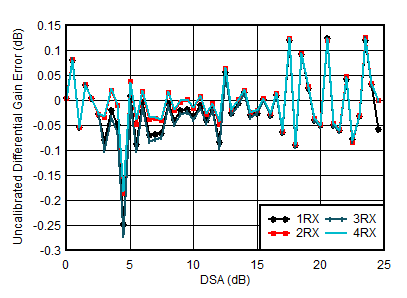
| With
1.8 GHz matching |
| Differential Amplitude Error = PIN(DSA
Setting – 1) – PIN(DSA Setting) + 1 |
Figure 7-312 RX
Uncalibrated Differential Amplitude Error vs DSA Setting at 1.75 GHz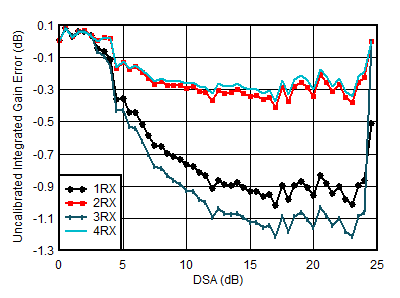
| With
1.8 GHz matching |
| Integrated Amplitude Error = PIN(DSA
Setting) – PIN(DSA Setting = 0) + (DSA
Setting) |
Figure 7-314 RX
Uncalibrated Integrated Amplitude Error vs DSA Setting at 1.75 GHz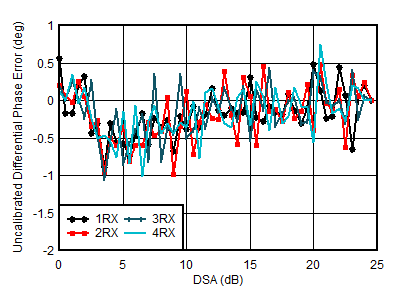
| With
1.8 GHz matching |
| Differential Phase Error = PhaseIN(DSA
Setting – 1) – PhaseIN(DSA Setting) |
Figure 7-316 RX
Uncalibrated Differential Phase Error vs DSA Setting at 1.75 GHz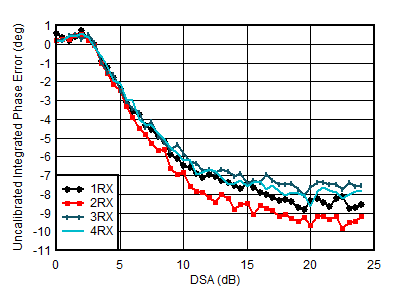
| With
1.8 GHz matching |
| Integrated Phase Error = Phase(DSA Setting) – Phase(DSA
Setting = 0) |
Figure 7-318 RX
Uncalibrated Integrated Phase Error vs DSA Setting at 1.75 GHz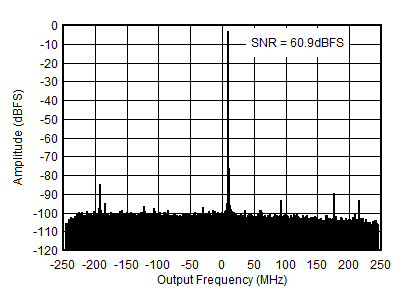
| With
1.8 GHz matching, fIN = 2610 MHz,
AIN= –3 dBFS |
Figure 7-320 RX
Output FFT at 1.75 GHz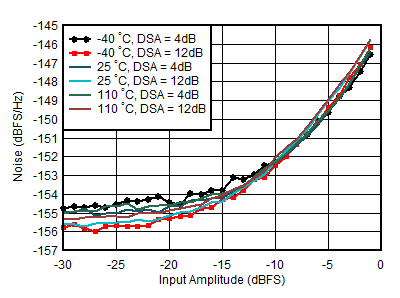
| With
1.8 GHz matching, DSA Setting = 12 dB, 12.5-MHz offset
from tone |
Figure 7-322 RX
Noise Spectral Density vs Input Amplitude and Temperature at 1.75
GHz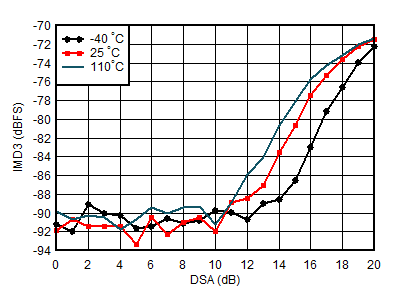
| With
1.8 GHz matching, each tone –7 dBFS, tone spacing = 20
MHz |
Figure 7-324 RX
IMD3 vs DSA Setting and Temperature at 1.75 GHz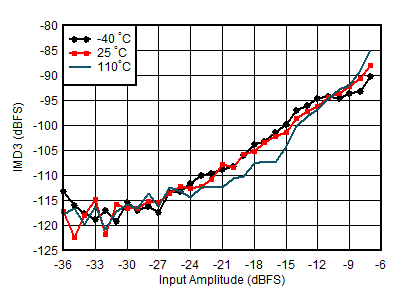
| With
1.8 GHz matching, tone spacing = 20 MHz, DSA = 12
dB |
Figure 7-326 RX
IMD3 vs Input Level and Temperature at 1.75 GHz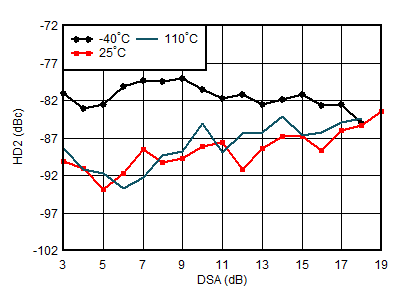
| With
1.8 GHz matching, fin = 1900 MHz, measured
after HD2 trim, DDC bypass mode (TI only mode for
characterization) |
Figure 7-328 RX
HD2 vs DSA Setting and Temperature at 1.9 GHz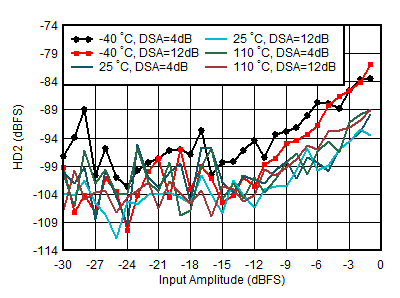
| With
1.8 GHz matching, fin = 1900 MHz, measured
after HD2 trim, DDC bypass mode (TI only mode for
characterization) |
Figure 7-330 RX
HD2 vs Input Amplitude and Temperature at 1.9 GHz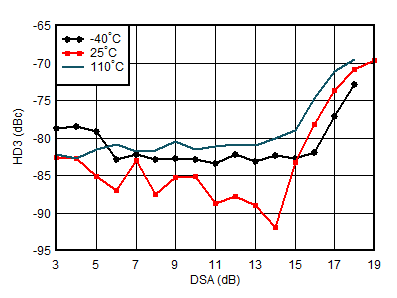
| With
1.8 GHz matching, fin = 1900 MHz, DDC bypass
mode (TI only mode for characterization) |
Figure 7-332 RX
HD3 vs DSA Setting and Temperature at 1.9 GHz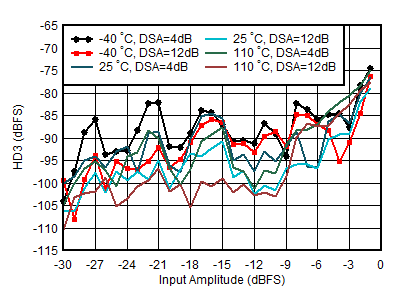
| With
1.8 GHz matching, fin = 1900 MHz, DDC bypass
mode (TI only mode for characterization) |
Figure 7-334 RX
HD3 vs Input Level and Temperature at 1.9 GHz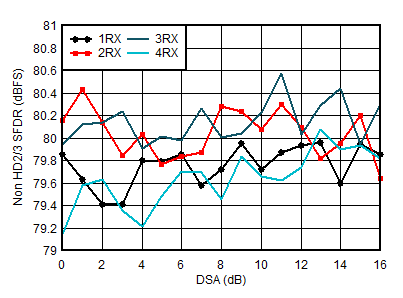 Figure 7-336 RX
Non-HD2/3 vs DSA Setting at 1.75 GHz
Figure 7-336 RX
Non-HD2/3 vs DSA Setting at 1.75 GHz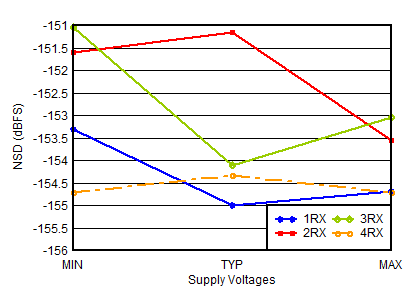
| With
1.8 GHz matching, 12.5-MHz offset, all supplies at MIN,
TYP, or MAX recommended operating voltages |
Figure 7-338 RX
Noise Spectral Density vs Supply and Channel at 1.75 GHz




























